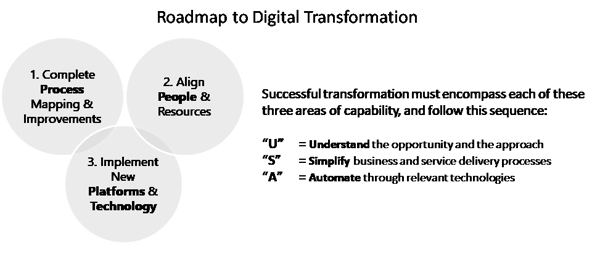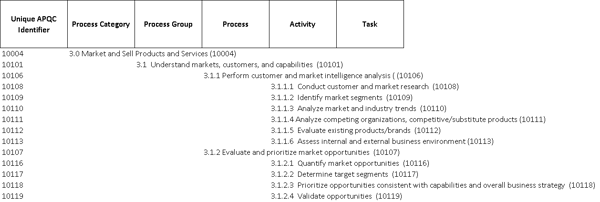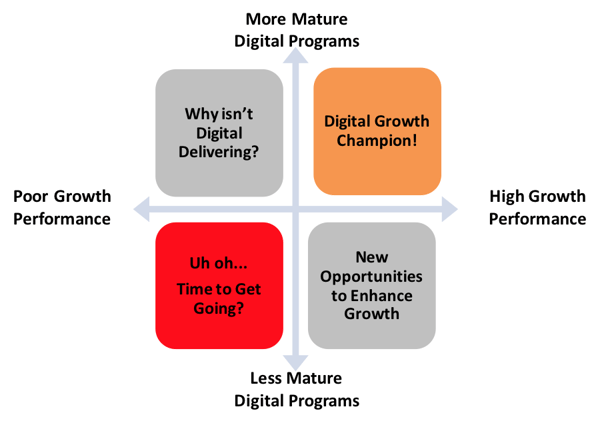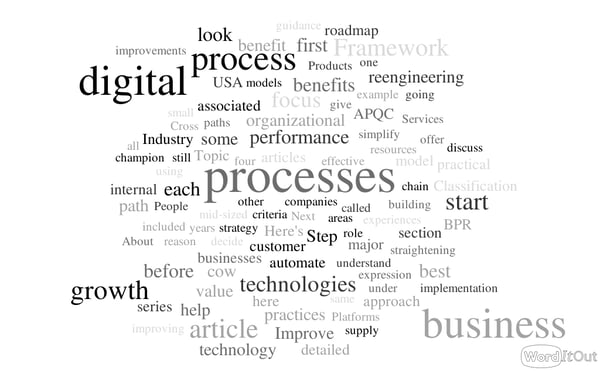CEO Blog - Advice for CEOs on growth and scaling
The Role of Processes in Digital Growth for Small- and Mid-Sized Businesses (SMBs)

 This is the second in a series of articles on helping executives in small- and mid-sized businesses utilize digital technologies effectively to assist in accelerating revenues and profits.
This is the second in a series of articles on helping executives in small- and mid-sized businesses utilize digital technologies effectively to assist in accelerating revenues and profits.
The previous article included an introduction to four major ways digital technologies can help your business, described a spectrum of technologies and a possible implementation roadmap, and associated digital proficiency with enhanced business performance. It also included a 10-question survey to help you set an internal benchmark for your digital programs.
In this article, I’ll provide practical guidance on where to start a journey for those businesses with a minimal digital growth path today.
You might be surprised that I’m not going to start with a discussion of technology. There’s a reason for that, and the reason is simply this: Until you understand what business processes you want to automate or digitize, you are out of order! From years as a CIO and as a CMO, I can tell you with confidence that processes come first, technology later.
Your approach should follow the Understand, Simplify, Automate (USA) model:

Growing up in Wisconsin, we have an expression “Paving the Cow Paths.” For those of you who are rurally-disadvantaged, cows walk behind each other using the same path, which tends to wind around. The analog here is simple. If you pave (that is, automate) the cow path, you still have the same winding cow path you had before. No operational improvements were derived from straightening it out by identifying process efficiencies or effectiveness. And now you have spent technology investment funding, while potentially losing major benefits.
Straightening the cow paths before automating those processes drives substantially larger benefit. That’s called business process reengineering (BPR), and before it got a bad name years ago because some companies used it as a proxy expression for “layoffs,” there is a large body of evidence that even without adding new technology, benefits are substantial. Today’s BPR still delivers multiple benefits, but goes under the names of “lean,” “six sigma,” or other specific methodologies.
Getting Started: Identifying and Prioritizing Processes for Digitization
If I have convinced you to start with processes before you think about technologies, then it is fair to ask which processes are the best to start with. The answer is easy. You can start with processes which are associated with each of the four major areas of digital benefits:
- Improve your business strategy and business model
- Improve your distribution channel presence and performance
- Improve your customers’ experiences
- Improve your supply chain performance
Each one of these areas of digital benefit is comprised of a series of business processes. Let me offer a practical guide on what to do next.
Step 1: Develop a process model. If you have a process model of your business, you can skip this step. If you do not, the APQC has a very helpful standard called the Process Classification Framework that you can simplify and adapt for your business.
There are several versions of the Process Classification Framework, and if you are one of the lucky companies where a detailed framework already exists, you have a running head-start at listing all associated business processes in your industry. If you cannot locate an industry-specific framework, the APQC’s 6.0.0 Cross Industry framework will work just fine.
The Process Classification Framework organizes all business processes into hierarchies by function. Here’s the index for the Cross Industry Framework:

Step 2: Select the processes you are most interested in digitizing. For example, if your strategy is to focus on improving your distribution channels and performance, look at the APQC processes under 3.0 (Market and Sell Products and Services) in their taxonomy. If you decide to focus on improving customer experiences, you might look at section 5.0. If you decide to focus on supply chain improvements, you might look at section 11.0.
Here’s a snapshot of what you will see if you view the APQC’s 3.0 section on Marketing and Selling Products and Services:

Each process is comprised of specific, detailed breakdowns of sub-processes, activities, and tasks.
Step 3: Evaluate the higher-level processes using these criteria:
-current performance (quality, time, cost)
-customer benefit and value
-internal benefit and value.
I would make this selection at the Process Category and Process Group level, for example, 3.1 (Understand Markets, Customers, and Capabilities). Otherwise, you might get too deep too early. This will help you further narrow down those processes that are candidates for reengineering, and then for digital automation. You are going to score each process on those criteria and select those that maximize customer value first, and secondarily the ones that also create internal value. This will give you a priority list of processes to put through the Understand, Simplify, and Automate (USA) approach.
Here’s an example of a process evaluation approach. Score each process “1-5.” You will be looking for processes with low performance scores and high value scores:

Step 4: Use process reengineering techniques to streamline those targeted processes.
This isn’t a process reengineering article, but I will point you in the direction of some good resources on how to do BPR from iSixSigma and KiSSFLOW.
And, here’s an incredibly detailed (and free) handbook from the U.S. Government Accounting Office.
Can We Finally Talk About Digital Technologies?
Not quite yet—we’ll get there when we look at Platforms. Before we actually discuss digital technologies, we need to look at best practices in people and organizational models. We are following the USA approach as we lay out a digital transformation roadmap.
Where to From Here?
Next up in our series of best practices to implement effective digital engines of growth in your business are these three follow-on articles:
Topic: People and Organizational Capabilities:
The focus will be on developing a healthy organizational growth culture, defining a “growth champion” role and prioritizing resources needed to support longer-term growth initiatives.
Topic: Platforms:
This article will examine building a robust set of enabling tools which fit into the business, adopting and standardizing scorecards, financial models, business cases and business plans, and completing periodic reviews of voice-of-customer VOC, competitive monitoring, and market analyses.
Topic: Roadmap, Results, Metrics, Benefits
This installment will emphasize effective adoption of best practices, offer a logical sequence to implementation, and discuss building organizational and program maturity. These articles will help you understand how to achieve “digital growth champion” status!
Please stay tuned for more practical guidance as we bring best practices for implementing engines of growth in your business.


Topics: Digital Marketing Tactics, Business Growth Strategy, Digital Marketing, Marketing Technology
Mon, May 14, 2018Related Articles

- Press Releases
- Careers
- Case Studies
- Marketing Consultant Company
- Marketing Strategy Consultants
- Marketing Plan Consultants
- B2B Marketing Consultants
- Virtual CMO
- Marketing Consultant Outsourcing
- Fractional CMO
- What is a Fractional CMO
- Healthcare Marketing Consultant
- Marketing Consultant Houston TX Texas
- Marketing Consultant Texas TX
- Marketing Consultant Bay Area
- CEO Blog
- Ebooks Plus
- Executive Marketing Consultants
- Product Marketing Consultants
- B2C Marketing Consultants
- Virtual Marketing Consultants
- Senior Marketing Consultants
- Temporary CMO
- Hire a CMO
- Fractional CMO Salary
- Fractional CMO Responsibilities
- Marketing Consultant Austin TX Texas
- Marketing Consultant Dallas TX Texas
- Marketing Consultant San Antonio
- Helping Private Equity
- Private Equity Blog
- Leadership Team
- Privacy Policy
- Business Marketing Consultants
- Strategic Marketing Consultants
- Marketing Technology Consultants
- Sales and Marketing Consultants
- CMO Job Description
- CMO Salary
- Fractional CMO Agency
- Fractional CMO Services
- CPG Marketing Consultant
- Marketing Consultant San Diego
- Partners
Houston, TX 77056
© 2023 Chief Outsiders


